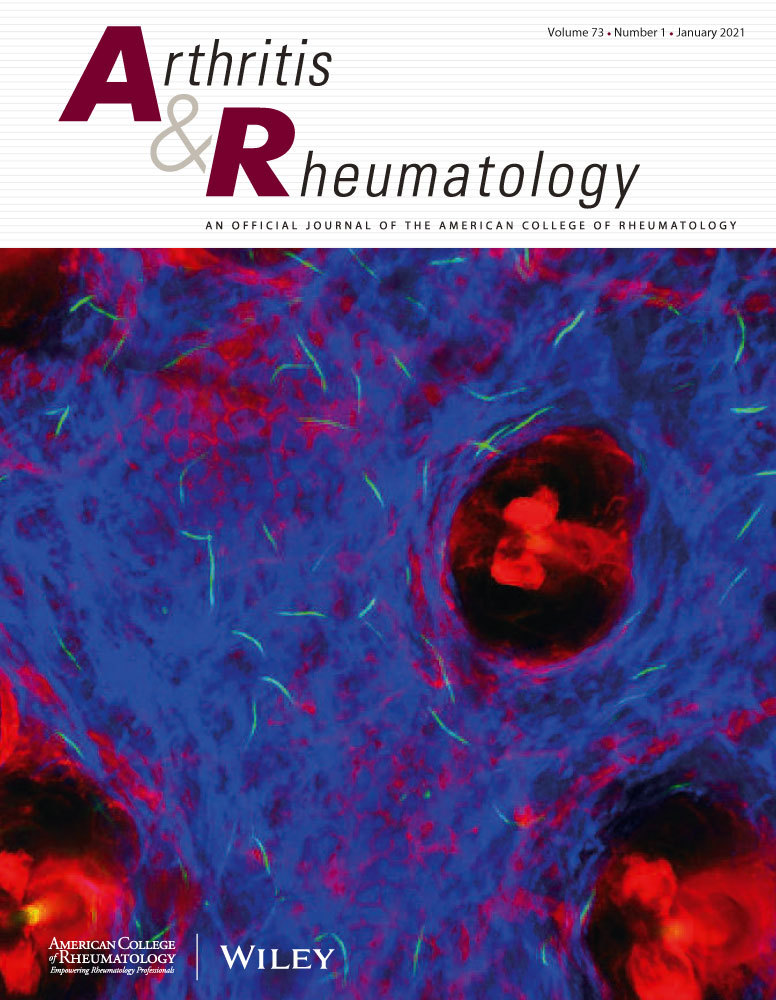Expert Perspectives on a Clinical Challenge: Hematologic Malignancies and Vasculitis
IF 11.4
1区 医学
Q1 RHEUMATOLOGY
引用次数: 0
Abstract
Systemic vasculitis describes a collection of rare diseases each caused by inflammation of blood vessel walls that can cause severe systemic complications [[3, 4]](#ref‐0003). The pattern of vascular inflammation and resultant damage is frequently variable and may be mimicked, or directly triggered, by infection or malignancy. Myeloid and lymphoid hematologic malignancy have long been recognized in association with vasculitis and were recognized by the 2012 Consensus Conference on the Nomenclature of Systemic Vasculitis as vasculitis associated with probable etiology (cancer‐associated) [[4]](#ref‐0004). We will refer to this as vasculitis with concomitant hematological malignancy (VCHM). This is a rapidly evolving field with limited but growing evidence base. Due to increased use of molecular diagnostics in hematologic clinical practice, rheumatologists should be aware of the diagnostic and treatment complexity in rare patients with VCHM, who often have refractory disease and are at risk of comorbidity from both hematologic and inflammatory disease and their treatments. Here, we discuss our collaborative approach to diagnosis and management of VCHM shared between rheumatology and hematology/oncology, in the context of relatively limited literature. We focus on myeloid neoplasia, as a clinically relevant model of the emerging recognition of overlap between our fields, with more limited discussion of associations with lymphoid forms of VCHM such as cryoglobulinemic vasculitis that have been previously discussed in the literature专家对临床挑战的看法:血液恶性肿瘤和血管炎
全身性血管炎是由血管壁炎症引起的一系列罕见疾病,可导致严重的全身并发症[[3,4]](#ref‐0003)。血管炎症和由此产生的损伤的模式经常是可变的,可能被感染或恶性肿瘤模仿或直接触发。髓系和淋巴系恶性血液病长期以来被认为与血管炎相关,并被2012年全体性血管炎命名共识会议认定为与可能病因(癌症相关)相关的血管炎[[4]](#ref‐0004)。我们将其称为血管炎伴血液学恶性肿瘤(VCHM)。这是一个快速发展的领域,证据基础有限,但不断增长。由于分子诊断在血液学临床实践中的应用越来越多,风湿病学家应该意识到罕见VCHM患者的诊断和治疗的复杂性,这些患者通常患有难治性疾病,并且有血液学和炎症性疾病及其治疗的合并症风险。在此,我们讨论风湿病学和血液学/肿瘤学在相对有限的文献背景下共同诊断和管理VCHM的合作方法。我们将重点放在髓系肿瘤上,作为我们两个领域之间重叠的临床相关模型,对淋巴样VCHM的关联进行了更有限的讨论,如先前文献中讨论的冷球蛋白性血管炎
本文章由计算机程序翻译,如有差异,请以英文原文为准。
求助全文
约1分钟内获得全文
求助全文
来源期刊

Arthritis & Rheumatology
RHEUMATOLOGY-
CiteScore
20.90
自引率
3.00%
发文量
371
期刊介绍:
Arthritis & Rheumatology is the official journal of the American College of Rheumatology and focuses on the natural history, pathophysiology, treatment, and outcome of rheumatic diseases. It is a peer-reviewed publication that aims to provide the highest quality basic and clinical research in this field. The journal covers a wide range of investigative areas and also includes review articles, editorials, and educational material for researchers and clinicians. Being recognized as a leading research journal in rheumatology, Arthritis & Rheumatology serves the global community of rheumatology investigators and clinicians.
 求助内容:
求助内容: 应助结果提醒方式:
应助结果提醒方式:


